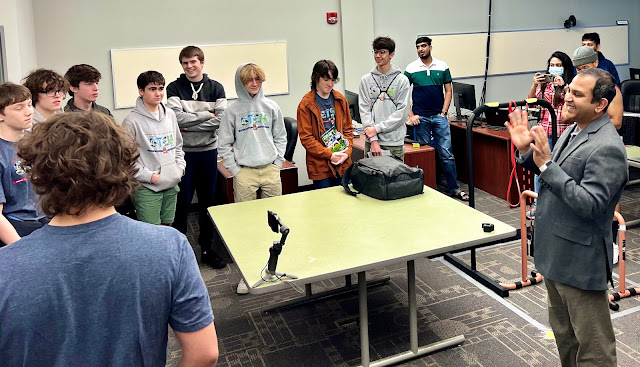2023-04-28: The Governor’s STEM Academy at Grassfield High School's Visit to ODU Computer Science Department
 |
| Dr. Sampath Jayarathna welcoming the students of Governor’s STEM Academy to ODU Computer Science Department |
On March 16th, 9th Graders from Grassfield High School Governor’s STEM academy visited ODU Computer Science Department. The Governor’s STEM Academy operates as a school-within-a-school and features a cutting-edge curriculum especially designed for students with an interest in STEM careers, and is located in Chesapeake, VA. Students attending the Governor’s STEM Academy take core academic courses as well as STEM elective courses from one of more of the three career pathways: Engineering and Technology, Programming and Software Development, and Global Entrepreneurship and Technology.
Members of NIRDS Lab, Accessible Computing Lab, LAMP-SYS Lab, and WSDL Lab took this opportunity to showcase their research work, findings, and lab equipment to the visitors from the Governor’s STEM Academy. They prepared hands-on activities along with presentations to keep visitors from Governor’s STEM Academy engaged and motivated while encouraging them to ask questions and experience activities. There were many examples of computer science being used in real life applications. NIRDS Lab and Accessible Computing Lab demonstrated their work in ESCB 2100, whereas LAMP-SYS Lab and WSDL demonstrated their work in ESCB 3102.
So glad @GrassfieldSTEM came to visit! We hope to see some of you back as @ODU undergrad or graduate students one day. Thanks to @NirdsLab, @WebSciDL for hosting! https://t.co/AItpb8Y9eK
— ODU Computer Science (@oducs) March 17, 2023
At this event, Gavindya Jayawardena explained and showcased the PupilLabs Invisible eye tracker. She also explained about eye tracking in general, how eye-tracking is an evolving technology, and what eye tracking is being used for.
Yasith Jayawardana presented what EEG is, what type of data it collects, and what it can be used for. He also demonstrated the CGX EEG headset along with their acquisition software. He discussed pros and cons of EEG, his past work, and conducting stream analysis in real time.
Yasasi Abeysinghe demonstrated the Tobii gaming setup with the Beatshot game and Tobii 4C eye-tracker. This provided students with an opportunity to experience eye-tracking controllers in real-life. They enjoyed playing the game only using their eyes.
Bhanuka Mahanama demonstrated his research work on distributed eye-tracking for online collaboration. He set up two identical computers to solve a Jigsaw puzzle with 40 pieces. There were two GazePoint GP-3 eye-trackers recording the eye movements of the participants. At these two setups, two students were given the opportunity to solve a single online Jigsaw puzzle. They could collaboratively solve the puzzle while communicating with each other.
Brian Hanson, Jr. demonstrated the Calisthenics setup with the Empatica E4. His goal was to discuss the research question: How can a wearable like an Empatica E4 wristband be leveraged to predict our Blood Glucose Concentration? He explained the following methods to answer the research question along with a live demonstration:
1. Execute calisthenics exercises while wearing the E4 wristband
2. Collect physiological signals while completing the exercise(s)
3. Analyze the signal data for Feature Engineering
4. Implement linear regression machine learning models for evaluation
More pictures!!! pic.twitter.com/Zo7RqjCfJe
— Sampath Jayarathna (@OpenMaze) March 16, 2023
Satwik Ram discussed problems faced by blind users while using web pages. He also gave an introduction to the deceptive content and demonstrated how to identify the deceptive content using AI techniques. Furthermore, he conducted a demonstration of sign language recognition on a live web camera.
Sandeep Kalari conducted a demonstration on how the images are converted into text using computer vision. He explained how to extract text from images and convert it to audio to make it more accessible to visually impaired people. He also discussed how difficult it is for blind individuals to browse restaurant menus leading up to a discussion of his research study which aids visually impaired people by converting restaurant menu images to text and text to speech so that the program can read out all of the text.
Mohan Krishna discussed their work on adding personal preference for discussion forms and making it more accessible for users. Further, he explained getting key content from the next page in websites like Amazon to make it easier for people who utilize screen readers to make choices when buying goods online.
.@WebSciDL group is demonstrating graduate projects to visitors from Grassfiled high school Governors STEM academy. @oducs @ODUSCI pic.twitter.com/6wBDQLEJ5Y
— Yasasi (@Yasasi_Abey) March 16, 2023
Kehinde Ajay described his research work on patent figure segmentation. He discussed their work on image segmentation and text extraction in patents, utilizing computer vision and natural language processing.
| Poster Presented by Kehinde Ajay |
 |
| Poster Presented by Muntabir Choudhury |
-- Gavindya Jayawardena (@Gavindya2)
Comments
Post a Comment